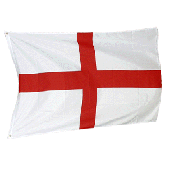April 23rd was declared International Book Day by UNESCO in 1995, but it has been celebrated as such in Spain since 1923. The reason why this day was chosen to represent the book is that two of the greatest writers in the world, Cervantes and Shakespeare, died on 23rd April 1616, and in the case of Shakespeare, he was also born on that day in 1564. Isn't it a coincidence?
 |  |
| William Shakespeare | Miguel de Cervantes |
April 23rd is also St. George's Day, as this soldier saint was martyred on this day. Since the 14th century, St. George is the patron saint of England and so April 23rd is England's National Day. But don't expect parades like on St. Patrick's Day, the English don't celebrate their National Day like the Irish or the Americans. Instead, they just wear a rose, the symbol of the nation, on the button hole, at the most! Other symbols of the English nation are the flag with St. George's cross, the three lions coat of arms and the English rose, which is traditionally red.
 |  |  |
| England flag or St. George's flag | Coat of arms | Tudor rose |
St. George is usually depicted on a horse with a spear in his hand, slaying a dragon. Legend has it that St George was travelling in Lybia when he heard that a dragon was ravaging the region. He was told that the dragon demanded a beautiful maiden as a sacrifice every day. Now it was the turn of the princess, as all the other maidens had already died. St. George fought the dragon and saved the beautiful princess. Apparently, in the place where the blood of the terrible creature had fallen, a rosebush flowered and the knight offered the lady a red rose. This is the origin of the tradition in Catalonia, Spain, where, on this day, women are given a red rose and men receive a book in return. St. George is also the patron saint of Catalonia, where he is known as “Sant Jordi”.
| Icon of St. George by Emmanuel Tzanes (1660-80), now housed in the Church of San Salvatore, Chania, Crete. |
Sant Jordi's day is really profitable for publishing companies, but you don't need to buy books, you can borrow them in the public libraries and, thanks to the initiative of a group of people from the web http://www.bookcrossing.com/ you can also find them in the streets. How is that? In this web you can register a book you want others to read. They provide you with a number that you stick on it. Then you choose a nice place where it can be found by other people. You will be able to trace where the book has been long after you have read it, and if you are lucky you can find another book, thanks to the generosity of other people.
April 23rd is the Day of the Book, but that doesn't mean that we should forget about them the rest of the year: by reading a book you can live other lives, feel what other people feel, travel all over the world. It's a fantastic and inexpensive way to experience new sensations. Try it!








